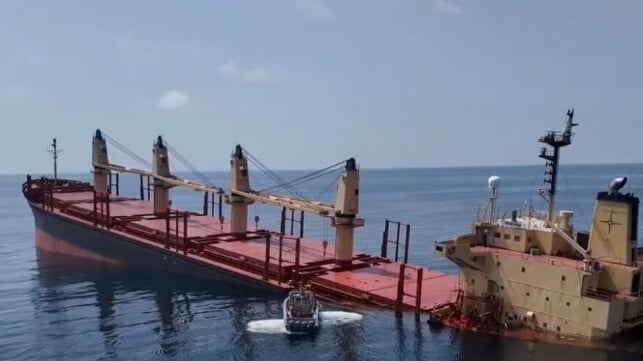The Red Sea Crisis, Food Insecurity and Conflict

[By Saba Sinai]
The Yemeni Houthi rebels’ continued attacks on shipping in the Red Sea serve as a reminder that global supply chains remain highly vulnerable to disruption. Moreover, it highlights how food insecurity can simultaneously be an effect and cause of conflict.
To address this, the international community must move quickly to combine its hard and soft power, mitigating the push and pull factors leading people to terrorism, violence, and piracy—factors that include food insecurity itself.
The UN Food and Agriculture Organization defines food security as ‘when all people, at all times, have physical, social and economic access to sufficient, safe and nutritious food that meets their dietary needs and food preferences for an active and healthy life’. The latest UN statistics suggest that 691 million to 783 million people are food-insecure, many of them in fragile and conflict-affected states.
This latest disruption in Red Sea maritime traffic has historical precedent. The name of the maritime area in question is Bab el-Mendab, which translates to ‘the gate of lamentations’ or ‘the gate of grief’. In the current episode of the maritime drama, the grief for millions of people who depend on the life-giving goods transiting through this narrow strait may yet wax greater.
The Houthis’ disruption of Red Sea maritime traffic has already significantly affected the global movement and price of goods for some nations. Container traffic has slowed, and 95% of the container shipping that once sailed through the Red Sea is now often diverted around Africa, adding nearly 5000km to the voyage in some cases. The additional distance is already significantly increasing the cost of such essentials as food, medicine and fuel. For the same reason, the Red Sea attacks are increasing the price of inputs for food and agriculture.
For the globe’s most vulnerable populations, cost increases of this kind threaten to exacerbate pressures on food security and precipitate the kinds of downstream consequences that erode prosperity and security, fueling conflict.
In response to Houthi attacks on shipping in the Red Sea, ongoing since the 19 November hijacking of an Israeli-linked ship, Galaxy Leader, the US initiated the multinational Operation Prosperity Guardian to protect maritime safety in the waters around Yemen. The operation received implicit endorsement from a UN Security Council resolution passed on 10 January. The next day, the US and Britain launched strikes against Houthi targets in Yemen.
Until 11 January, it seemed Operation Prosperity Guardian would only respond to Houthi attacks if the group successfully damaged civilian or military vessels. Some may read the two-month delay in responding to Houthi attacks as a vulnerability in the international system ripe for exploitation.
It’s unlikely that a state, perhaps except Iran, whose government has form on this matter in the Strait of Hormuz, would engage in such tactics around the world’s eight most important maritime chokepoints. They are Bab el-Mandeb at the Horn of Africa; the Strait of Hormuz in the Persian Gulf; the Suez Canal, Egypt; the Panama Canal, Panama; the Strait of Gibraltar, between Spain and Morocco; the Strait of Malacca between Malaysia, Singapore and Indonesia; the Turkish Straits, Turkey; and the Cape of Good Hope, South Africa.
Whether by design or accident, the Houthis renown has received a boost from the maritime attacks. Other non-state actors may get inspiration from the Houthis’ use of these attacks to achieve political, ideological and military objectives. Of particular concern are the militant groups that operate around Bab el-Mendeb.
Beyond the immediate challenge of maritime terrorism and insurgency, events in the Red Sea are a reminder of the role of food insecurity in conflict. As former WFP executive director David Beasley outlined, ‘there is plenty of information on how conflict impacts food security, but there is very little evidence on how food insecurity can drive conflict or how food security might contribute to the building of more peaceful societies’.
Nevertheless, food insecurity can sometimes be linked to factors that promote conflict: the recruitment of combatants; mortality and morbidity rates that undermine stability in already fragile societies; disputes over land and water in resource-constrained settings; and the mass displacement of food-insecure people. The 1992 famine in Somalia illustrated how food insecurity could accentuate political, economic or social dysfunction.
The tragic irony of the Houthis attacks is that hunger is rife across Yemen itself, where 17 million people are food-insecure. Food insecurity has undoubtedly continued to undermine peace and stability in Yemen. It has been exacerbated by the conflict there and used to radicalise Yemenis to the Houthis’ cause. Strikes on Houthi positions and facilities through Operation Prosperity Guardian or otherwise under the Security Council resolution could deepen Yemen’s humanitarian disaster if such action harms civilians or civilian infrastructure.
Governments and multilateral bodies, particularly through the UN, must work to secure maritime trade to avoid food insecurity contributing to further conflict in the Middle East and beyond.
Saba Sinai is a lecturer in agriculture at CQUniversity, Australia and a fellow with ASPI’s Northern Australia Strategic Policy Centre. The views expressed here are his own and do not necessarily represent those of his employer.
The opinions expressed herein are the author's and not necessarily those of The Maritime Executive.
